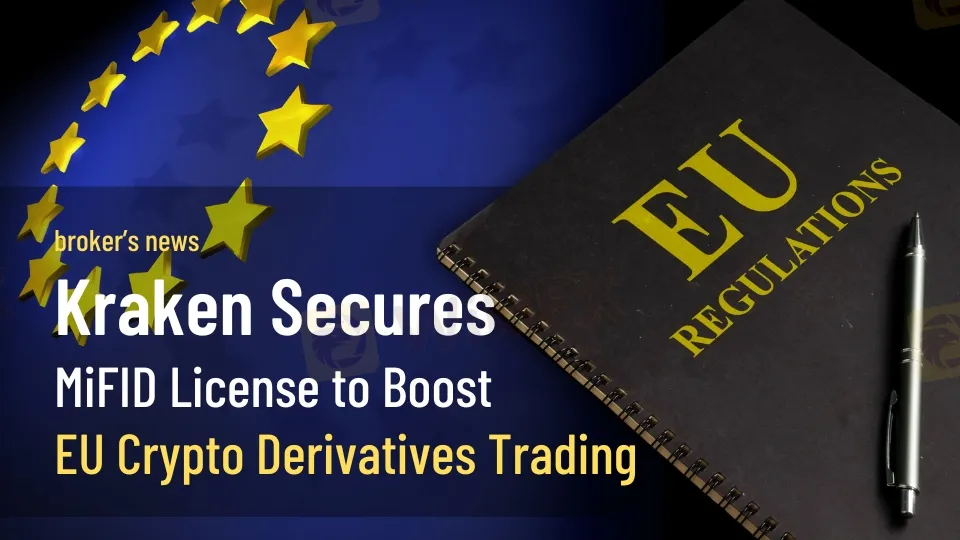Kraken Secures MiFID License to Boost EU Crypto Derivatives Trading
Abstract:Kraken obtains MiFID license in the EU, enabling regulated crypto derivatives trading. New stablecoins USDR and EURR now available for trading.

Kraken Expands Its Reach in the EU with MiFID License
Kraken, one of the top cryptocurrency exchanges, has made a major move by securing a Markets in Financial Instruments Directive (MiFID) license in the European Union. This achievement came through the acquisition of a Cypriot Investment Firm, which has been authorized by the Cyprus Securities and Exchange Commission (CySEC). With this MiFID license, Kraken is now able to offer fully regulated and compliant derivatives products to advanced crypto traders in select European markets.
This step marks Krakens dedication to meeting the increasing demand for safe and regulated cryptocurrency trading in Europe. The company is preparing to meet the necessary conditions to introduce its products in local EU markets in the near future.
A Commitment to Secure Crypto Trading in Europe
“As we expand our global footprint, we continue to prioritize the European market,” said Shannon Kurtas, Co-General Manager of Kraken Pro & Exchange. “This acquisition is a testament to our belief in the EU and emphasizes our commitment to offering a reliable, regulated environment for advanced crypto traders and investors.”
Europe is known for its active crypto derivatives market, making it a crucial area for Kraken‘s growth. The ability to provide regulated, fully compliant products from an EU-regulated base aligns with Kraken’s strategy to serve the needs of experienced investors.

Krakens legacy of breaking new ground in regulated crypto trading goes back to 2019, when it acquired Crypto Facilities, a U.K. FCA-regulated platform for crypto futures, marking the launch of the first licensed crypto futures platform in the UK.
New Stablecoins are Now Available on Kraken
In addition to the MiFID license achievement, Kraken has also announced two new stablecoins for trading: StablR USD (USDR) and StablR EUR (EURR). Funding for these stablecoins began on January 31, 2025, at 17:00 UTC, with trading set to begin on February 1, 2025.
StablR EUR (EURR): EURR is a stablecoin fully backed by reserves and pegged 1:1 to the euro. Created to facilitate smooth cross-border transactions and decentralized finance (DeFi) applications, EURR is supported by a combination of cash reserves and real-world assets, ensuring reliability and liquidity for users in search of a dependable euro-backed digital asset.
StablR USD (USDR): USDR is a USD-pegged stablecoin that maintains a 1:1 value with the U.S. dollar. Compatible with the ERC-20 token standard on the Ethereum blockchain, USDR merges the stability of fiat currency with the speed and efficiency of blockchain technology, enabling secure, seamless transactions within the Ethereum network.
Kraken users can now deposit these stablecoins into supported networks via their Funding section. Its important to note that deposits made through unsupported networks will not be credited. Trading via Kraken App and Instant Buy will become available once liquidity requirements are met.
Setting the Bar for Crypto Trading Standards
Krakens latest developments demonstrate its ongoing commitment to setting the benchmark for security, innovation, and regulatory compliance in the crypto industry. By expanding its regulated offerings and introducing new stablecoins, Kraken continues to provide exceptional trading experiences for its growing EU client base.
As the cryptocurrency market evolves, Kraken remains at the cutting edge, offering advanced traders efficient and flexible trading options while keeping a firm focus on regulatory compliance and maintaining user trust.

Read more

RM 2.1 Million Lost: How a Company Director Fell for a Crypto Scam
A 77-year-old company director lost RM2.1 million after becoming a victim of a fraudulent investment scheme on cryptocurrency exchange platform. The incident occurred after he came across an advertisement on Facebook promoting a cryptocurrency investment opportunity in August.

Indian FIU Fined Bybit $1 Million for AML Non-Compliance
Bybit faces a $1.06M fine in India for regulatory violations, leading to service suspension amid stricter crypto compliance measures.

Crypto.com Aims to Launch Cronos (CRO) ETF by 2025
Crypto.com plans to launch a Cronos (CRO) ETF by 2025, expanding its offerings with stocks, banking features, and a stablecoin amid regulatory scrutiny.

$10.25 Million Lost to Phishing Scams in Crypto Sector in January
In January 2025, crypto phishing scams showed a decline in overall losses but a significant rise in attack sophistication.
WikiFX Broker
Latest News
Robinhood Halts Super Bowl Betting Contracts After CFTC Request
3-Day Online Scam Trap: Victims Lose $200K—Don't Be Next!
Japan's January PMI has been released, investors need to pay attention to these points!
Investment Scam on Telegram: How a Woman Lost Over RM65,000
Spotting Red Flags: The Ultimate Guide to Dodging WhatsApp & Telegram Stock Scams
WikiFX Review: Why so many complaints against QUOTEX?
Trans X Markets: Licensed Broker or a Scam?
Carmaker Kia becomes latest global firm to face tax trouble in India
Judge halts Trump\s government worker buyout plan: US media
Why Do Countries Buy Gold and What Impact Does It Have on Gold Prices?
Rate Calc
